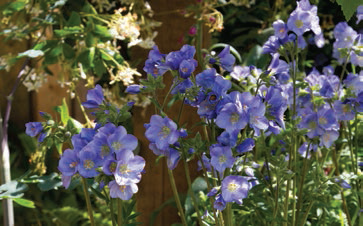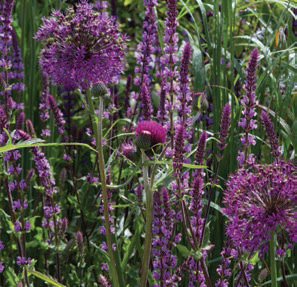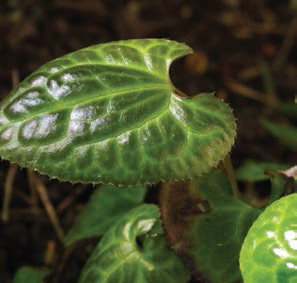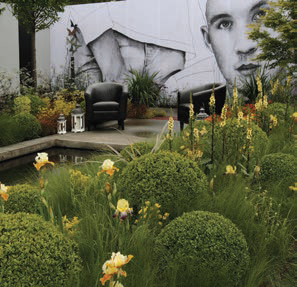Respected plantsmen, Jimi Blake, and John Joe Costin present two perspectives on the quality of plants and planting design at this year’s Bloom in the Park
| This year’s Bloom gardens were an eclectic mix of the well composed and constructed, the artfully underpinned and the hastily assembled. There were examples of beautifully nuanced planting but there was also evidence of the ill-considered, poorly planned and hurriedly executed. To gain a more in-depth insight into the planting at Bloom 2015, we asked two of Ireland’s leading experts to share their thoughts. As owner and custodian of Hunting Brook Gardens, Jimi Blake is one of Ireland’s most highly regarded contemporary plantspeople. With an eye for spotting and forging new trends, he is a go-to plant lover for everything that is fashionable, creative and experimental in the world of plants. Here, Jimi shares his thoughts on the gardens and some of the plants he thought stood out from the rest.
John Joe Costin is considered one of the founders of Ireland’s nursery industry. He has been involved in commercial horticulture for over 50 years, has travelled the world, written extensively on horticultural matters and has a multi-generational insight into what grows well and what doesn’t on this island. Here he lends his considerable insight into this year’s planting and how things might move forward. |
A FAVOURITE PERSPECTIVE, JIMI BLAKE
May is the month when it all happens, and when the gardens at Hunting Brook are growing faster than at any other time and I make my flying visit to Chelsea Flower Show, the Rare & Special Plant Fair, and lastly Bloom Garden Festival in the Phoenix Park.
This year I attended Bloom with a mission to choose favourite plants from the show gardens. This task was more difficult than I had anticipated after I kept getting waylaid in the nursery marquee. Eventually, after meeting many gardening friends, I got to the show gardens and started searching out my favourite plants.
The May gap in flowering is when the garden moves graciously from late spring into summer when gardens tend to be more green than colourful and more muted than textural. It’s a time when the beauty of the unfurling of new growth takes centre stage. Creating an impact in May is a real challenge and the Bloom show garden creators have to work extra hard to realise any sense of theatre. I face the same limitations at Hunting Brook and am always on the lookout for new contenders to fi ll the May colour gap. The May palette is limited but it is not limited to foxgloves and lupins. See my recommended list at the end of this feature.
Among the lupins and foxgloves, I did find some plants of merit, a few treasures worthy of use and exploration. Here are my eight favorites from the gardens.
1. Salvia nemorosa ‘Amethyst’
Salvias are the height of fashion at the moment with new varieties to choose from each year. I spotted this wonderful herbaceous Salvia in Jane McCorkell’s garden, grown to perfection by Kilmurry Nursery. The slender stems of lilac-purple add vertical interest to the summer garden. The main flowering starts in late spring / early summer. Salvias like to grow in full sun in the fertile well-drained soil. Tender salvias are my latest obsession!
2. Mahonia ‘Soft Caress’
I remember a few years ago when I visited Piet Oudolf’s garden and purchased this new Mahonia. I was so excited about bringing it back to Ireland where it had not yet been launched. I planted it in the woods where it sat doing nothing for a few years but then last summer it transformed into a graceful small shrub until a sheep broke it and ate half of it. Apart from that, I highly recommend it for semi-shade. It’s ideal for a small space, even in a container, as was cleverly used by Nathalie Markiefka in her north facing balcony garden.
3. Bessia calthifolia
I was delighted to see this new woodland plant used in a show garden. In 1996 the modern day plant hunters Bleddyn Wynn-Jones and Dan Hinkley found it for sale in Japan and reintroduced it to the trade.
This is a very subtle plant with small star-shaped, greenish white flowers with heart-shaped, serrated leaves. Grow it in semi-shade in good garden compost. I have always had problems growing it due to its popularity with the West Wicklow slug population but don’t let that stop you trying this woodland gem.
4. Polemonium ‘Sonia’s Bluebell’
As a child I remember Polemoniums, or Jacob’s Ladder as my mum used to call them, growing in our herbaceous borders at home. Many of the older cultivars were either invasive or died out easily. ‘Sonia’s Bluebell’ is originally from Carol Klein’s Nursery at Glebe Cottage, and has soft pale blue flowers with a beautiful scent, lasting for weeks. Polemonium likes moist fertile soil in sun or part shade. Breffni McGeough had them beautifully planted on the edge of woodland in his show garden.
5. Iris ‘Edith Woodford’ is a tall bearded Iris with a mix of canary yellow and lilac ruffled flowers. Plant bearded Iris with the upper part of the rhizome partially exposed to get summer baking. They will not tolerate competition from other plants and waterlogged soil. Niall Maxwell used this Iris in his beautifully planted garden, growing through Stipa tenuissima.
6. Wisteria x formosa ‘Issai’
As I walked past Tünde Szentesi’s quirky garden, my nose met this deliciously scented Wisteria. This stunning variety of Wisteria it is a cross between Japanese and Chinese Wisteria. ‘Issai’ is a variety with mauve flowers with a central greenish-blotch. Wisteria flowers best in full sun without feeding, which will encourage more growth than flowers.
7. Anthriscus sylvestris ‘Ravenswing’
Cow parsleys are at their prime of popularity. They stole the show at Chelsea and were beautifully planted in Niall Maxwell’s garden under a canopy of Carpinus. They will grow in dappled shade to full sun in soil that’s not over-enriched. What I liked most about this garden was that, unlike most show gardens, it wasn’t over-planted.
8. Podophyllum ‘Spotty Dotty’ has marbled, spotted foliage resembling a big old toad and blood red flowers hanging down under the leaves. It takes a few years to grow into a decent sized plant but is well worth the wait. Plant it in dappled shade and good rich garden compost. I saw this in Liat Schurmann’s garden, which was a breath of fresh air with its fascinating collection of plants put together so skillfully.
Next year I hope to see more garden designers stepping outside their comfort zone and creating exciting, cutting-edge and inspirational planting compositions, ones that will attract me and Ireland’s population of plant lovers to attend. I believe that sponsorship deals for the gardens are often not secured until very late, leaving little time for them to source a wider plant selection and also time for the nurseries to grow them. This should be addressed.
Well done to all the designers who created gardens this year and especially those who took the risk and used some new and exciting plants. I hope next year will be the year that the Bloom show gardens are taken to a new level and I can go home inspired to use some of the plants and combinations in my own gardens at Hunting Brook.
Jimi’s suggestions for filling the May colour gapGeranium sylvaticum ‘May Flower’ |
THE LONG TERM PERSPECTIVE, JOHN JOE COSTIN
Those of us asked to represent the nursery industry on the government appointed Bord Glas Advisory Committee in 1987 felt we had experienced heaven without the actual inconvenience of dying. It was the first time a department obsessed with food production had put ornamental plants on a par with food crops. It was a belated recognition that the production and use of garden plants offered food for the mind and spirit and that gardening was more than just an expressive indulgence or exclusive hobby of the better off. It acknowledged for the first time, that this was a sector with growth potential, which could be harnessed sooner if some much-needed state aid was provided. When Bloom was launched in 2007, we finally had a professional realisation of a concept that there was unanimity on its necessity, which had been previously attempted by different enterprising bodies, but each attempt failed because of inadequate fi nances to fully realise that potential.
Gardeners flocked to Bloom, they were enthused by the ease of access, the magnifi cent location, superb facilities, excellent communications and marketing skills. It engendered a proud affirmative, ‘we are as good as you’. We no longer had to look enviously at shows abroad.
Bloom’s professional standards relegated all prior national garden shows to the third division. However, in the past four years especially, I detected a sense of dissatisfaction among keen gardeners. Their initial enthusiasm has not been sustained and the promise, they now realise, is not being fulfilled. Their gripe is that there is not much to enthuse the keen gardener at Bloom. Keen gardeners are found in every village and parish across the country. They are the go-to people in their areas and occupy positions where their opinions are sought and valued as members of local organisations such as the ICA, Tidy Towns committees and flower clubs. They are the local arbiters of taste. If their enthusiasm for Bloom is waning, Bloom is in crisis if they withdraw their approval.
Flower arrangers are a good weathervane. They have extraperceptory senses. They look for features in plants that others are not aware of. Give one a Danae racemosa or a Bupleurum fruticosum and watch their reaction. Last year, one shook her head at me in disbelief and dismay at what she was seeing. “Bloom is not a good show for plants.” The keen gardener at Bloom now goes away unchallenged and disappointed. Where is the expected plantsmanship to state the eyes and minds of the enthusiast?
The media likes to believe its duty is to hold the government to account. That’s why it provides an almost daily platform for people from a wide range of organisations to air their grievances and bemoan opportunities lost because the government had not provided the small amount of capital needed to synergise the said activity.
In the horticultural industry, the government has generously funded Bord Bia, who in turn invested heavily and created in Bloom, a showcase for our industry that nine years ago we could not have imagined in our wildest dreams. No spokesperson in our industry could accuse the government of not having provided everything that was needed, especially when severe cuts in a time of economic crisis could have been justifi ed.
Instead, after the ninth Bloom garden festival, the government might well ask the industry why it has not grasped the opportunities provided.
There is disarray in the landscape industry. The word ‘designer’ is becoming what the advertising world calls a ‘weasel word’.
It connotes creativity and originality but is ambiguous on professional qualifi cations and can disguise what in medicine is called ‘quacks’. Bloom designers range from fully qualifi ed landscape architects to those who have completed short-term correspondence courses of varying repute. The gardens created reflect this imbalance. The education sector has questions to address.
A former director of the National Botanic Gardens stated that 20,000 species of hardy plants grow in Ireland. Yet, visiting Bloom one gets the impression that the designers have little plant knowledge or that they are restricted in their choice to what is available in abundance. They are the authors of the crisis that Bloom is in now.
Gold medal standard requires precision in the build detail. I have listened to an anguished architect whose otherwise gold medal creation was downgraded to a
“After the ninth Bloom garden festival, the government might well ask the industry why it has not grasped the opportunities provided”
silver gilt because one riser in a flight of steps was built a fraction higher than the others. What I do not understand is, why the plant selections are not judged by similar exacting criteria. We might consider taking inspiration from shows like Chaumont which place more emphasis on the planting and horticultural components of a landscape design. It runs for fi ve months compared to our fi ve days. Plant performance can be evaluated over a longer period.
At Bloom, plants that grow in polar opposite habitats were planted adjacent to each other, perhaps to achieve a contrast in texture or flower colour. They would not survive in a five month garden festival or in a private garden if the arrangement was copied by a gullible gardener, who trusted that he/she could replicate what the ‘experts’ had done at Bloom. These opportunistic arrangements are misleading to the viewing visitors seeking inspiration. To see what is new or what is different are two very compelling reasons for people to attend Bloom. They
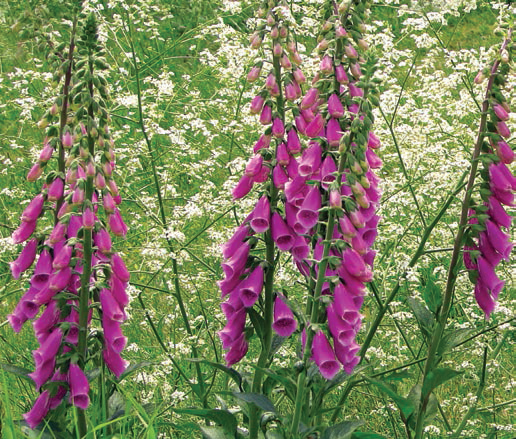
“Again, birch was overused and was planted in 12 show gardens. Every show garden seemed to have Digitalis purpurea ‘Pams Choice’, a woodland biennial”
should not be misled. Why give an award to a designer who includes an olive specimen in his show garden? Olives detest humidity and will not survive in an Irish garden. There was no warning notice to that effect. Pyrus salicifolia ‘Pendula’ will survive. It is a very attractive, elegant, weeping tree, the perfect alternative to the olive. It was not used.
The word ‘designer’ is freighted with meaning and has cachet or marketing values in the public’s mind. Creative, stylish, fashionable, refi ned and co-ordinated are some of the expectations clients have when they pay a fee to engage one. Most of all, clients with means expect exclusivity that will segregate their property from the DIY garden.
At Bloom 2015, few of the designers’ gardens acknowledged this raison d’être. Most seemed to have worked with the same limited palette of plants. Again, birch was overused and was planted in 12 show gardens. Every show garden seemed to have Digitalis purpurea ‘Pam’s Choice’, a woodland biennial. Topiary specimens of box, hornbeam and yew were ubiquitous. They are for warmer climates where the shape is replicated in the shadow on the ground in matching symmetry. Our own William Robinson in 1925 put the kibosh on that fashion, discrediting its use in Britain. Unthinkingly, we have unlearned what was learned. The solid rigidity of topiary looks alien here in a landscape of fluidity, the second windiest land in the northern hemisphere. Our forte should be wind responsive plants. Topiary is now a jaded cliché at Bloom, and a contradiction of the promise of site-sensitive solutions promised on designers’ websites.
How do judges judge? Are they inspectors of standards who measure levels of compliance? If so, the Best in Show was the correct adjudication. However, if they judged as consumers do, the winners’ list would change.
People attend shows to be inspired, to view the new and see the potential. Digitalis in one garden is a delight but if planted in every garden it loses its allure. In a market where the spend is discretionary, consumers do not want what is ubiquitous. Proud property owners who garden, want it to reflect well on themselves.
Such branding is not about the commonplace or the prosaic. If the criteria for planting included the new, range and variety, then the Best in Show accolade would be placed elsewhere.
Clearly, 20% of the exhibits were ‘space fillers’. The remnant of a New Age Community in Dunmanway might accept the gift of the shed made from recycled materials, but imagine the legal bill if one attempted to erect it in one of our more salubrious suburbs. The question has to be asked, what contribution did they make to the show?
Participation should be more onerous. In 1984, I tendered for the supply of a range of ornamental grasses to the Liverpool Garden Festival. I received the entire order. When I asked how many competitors I had, they replied that ours was the only tender received. In 1987, I submitted a design to the 1988 Glasgow Garden Festival organisers for an ornamental grass show garden. They observed that they were not aware of such a concept, and if it failed they would have an embarrassment on their site for the five months duration of the show. To participate, they placed the onus on us to perform and required that I provide a bond of £37,600 sterling (about €86,000 in today’s money) which would be cashed in if the garden failed. We received the Gold Medal for the Most Innovative Garden. It was viewed by 4.3m visitors.
The organisers of Bloom might consider a similar idea. For those who received bronze or no award this year, entries should not be accepted from them for Bloom 2016.
These spaces could then be allocated to nurseries to exhibit new plants, or societies to show educational collections. By doing so, the public could view a specifi c range of plants that succeed in one of a number of difficult habitats that they might be contending with. These might include heavy shade, heavy soils, well-drained soils, seaside locations, hedging options, wall plants, collections suited to balconies and plants desired by flower arrangers, among others. It would be a better use of space and eliminate the obvious ‘space fillers’ that besmirched Bloom 2015. ✽




